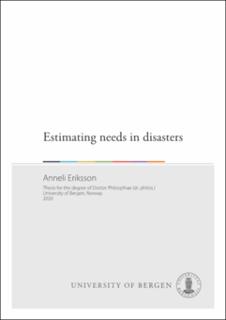| dc.contributor.author | Eriksson, Anneli | en_US |
| dc.date.accessioned | 2020-05-22T06:23:38Z | |
| dc.date.available | 2020-05-22T06:23:38Z | |
| dc.date.issued | 2020-06-09 | |
| dc.date.submitted | 2020-05-18T10:12:44.352Z | |
| dc.identifier | container/cf/b0/4d/e8/cfb04de8-d5d0-40c2-8958-5ded9f5f6474 | |
| dc.identifier.isbn | 9788230857991 | en_US |
| dc.identifier.isbn | 9788230850589 | en_US |
| dc.identifier.uri | https://hdl.handle.net/1956/22328 | |
| dc.description.abstract | Introduction: In 2019, more than 130 million people were affected by disasters caused by natural, man-made or mixed hazardous events that overwhelmed local capacity, necessitating international humanitarian assistance. Such assistance is predominantly funded by governmental agencies and should, according to international agreements, be based on needs. However, as needs are greater than available funding, donors must rationalise funding in proportion to the scale of needs. To date, there is no commonly accepted tool to guide needs-based funding of humanitarian assistance. The aim: of this thesis was therefore to increase the understanding of what factors contribute to disaster severity and how they can be measured in order to estimate the scale of needs in disasters. Methods: The three thesis papers build on the assumption that a limited number of readily available indicators of vulnerability, exposure and magnitude of the hazardous event can be included in a composite index that indicates or predicts the severity and the scale of needs in disasters. Papers I and II explore and define estimates of the scale of needs in conflicts and other types of complex emergencies. Paper III explores estimates that can predict the scale of needs after earthquakes. In the first paper (I), a model to distinguish the severity and the scale of needs was developed through a two-step literature and Internet search that identified more than 100 indicators. A core set of six indicators was selected through rankin. A basic model, based on the Utstein style framework for disaster research and evaluations was developed. In the second paper (II), the usefulness of the developed model was assessed through application to 25 countries affected by complex emergencies, using data from 2013 to 2015. The validity was assessed by applying it to 11 complex emergencies, and the results were plotted against excess mortality. In the third paper (III), the predictive performance of the indicators from four commonly used disaster indexes, in total 26 variables, was assessed through data from earthquakes for the period 2007 – 2016. The assessment was performed using linear regression with root mean square error (RMSE) as the performance measure. Main results: Data for vulnerability and exposure was identified to indicate severity and in turn the scale of needs in disasters. The vulnerability indicators were as follows: 1) GNI per capita, PPP, 2) under-five mortality rate per 1 000 live births, 3) adult literacy rate: proportion among people aged 15 and older, and 4) underweight: proportion of the population under 5 years. The two exposure indicators were as follows: 1) number of persons and proportion of population affected and 2) number of uprooted persons and proportion of the population uprooted. The required data were largely available for all countries. With these indicators a model was developed, that was able to discriminate between levels of severity and needs among countries and to correlate with excess mortality. The assessed variables did not predict the scale of needs after earthquakes, individually or in multivariable models. Conclusions: Data on vulnerability and exposure can be used to estimate severity and the scale of needs in conflicts and other types of complex emergencies. Out of the selection of indicators from commonly used disaster indexes, none are able to predict the scale of needs after earthquakes. | en_US |
| dc.language.iso | eng | eng |
| dc.publisher | The University of Bergen | eng |
| dc.relation.haspart | Paper I: Eriksson A, Ohlsén YK, Garfield R, von Schreeb J. Who is worst off? Developing a severity-scoring model of complex emergency affected countries in order to ensure needs-based funding. PLOS Currents Disasters. 2015;7. Edition 1. The article is available in the main thesis. The article is also available at: <a href="http://currents.plos.org/disasters/index.html%3Fp=25295.html" target="blank">http://currents.plos.org/disasters/index.html%3Fp=25295.html</a> | en_US |
| dc.relation.haspart | Paper II: Eriksson A, Gerdin M, Garfield R, Tylleskär T, von Schreeb J. How Bad Is It? Usefulness of the “7eed Model” for Scoring Severity and Level of Need in Complex Emergencies. PLOS Currents Disasters. 2016;8. Edition 1. The article is available at: <a href="http://hdl.handle.net/1956/12716" target="blank">http://hdl.handle.net/1956/12716</a> | en_US |
| dc.relation.haspart | Paper III: Eriksson A, Wärnberg M G, Tylleskär T, von Schreeb J. Predicting the unpredictable – Harder than expected. Prehospital and Disaster Medicine. 2020;35(2):174-183. Full text not available in BORA due to publisher restrictions. The article is available at: <a href="https://doi.org/10.1017/S1049023X20000217" target="blank">https://doi.org/10.1017/S1049023X20000217</a> | en_US |
| dc.rights | In copyright | eng |
| dc.rights.uri | http://rightsstatements.org/page/InC/1.0/ | eng |
| dc.title | Estimating needs in disasters | en_US |
| dc.type | Doctoral thesis | |
| dc.date.updated | 2020-05-18T10:12:44.352Z | |
| dc.rights.holder | Copyright the Author. All rights reserved | |
| dc.contributor.orcid | https://orcid.org/0000-0003-3154-7247 | |
| fs.unitcode | 13-26-0 | |
